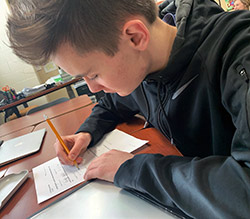Algebra I is all about factors. Considering that, it makes sense for Byron Center High School teachers to zero in on the X and Y in what makes skilled and confident math students.
“Statistically if you do poorly in algebra, it is a huge indicator of how your entire high school GPA will be,” said teacher Stephanie Kladder. Research backs up that statement, including success in algebra as a big indicator of high school success and college readiness.
She and fellow algebra I teachers Ted Lang, Anna Bialockowski and Kellie Merrit are using an approach that involves teacher collaboration and student ownership of every single standard needed to build the foundation required for higher level math.
Forget cramming notes on a study guide before a test. The school’s 270 Algebra I students focus on what they know and don’t know all the way through each unit. For each lesson, students are quizzed — not for a grade, but so they are aware of how they did on each math standard, or “learning target” as they are called.
“It’s to give them feedback on every single learning target we expect them to know before a (test),” Kladder said.
Students input their scores on each target into a computer program (or on a paper graph), creating a visual reference of how close they are to mastery.
“We are so big on this — having students track themselves,” Kladder said. “It allows a really nice accountability piece and a feedback piece.”

For example, on a graph in Kladder’s class, one student tracked his progress on Learning Target #4: Writing and Using Scientific Notation. His answers from a lesson check following Kladder’s instruction showed he got 50 percent right. The student relearned material before taking a quiz. His graph then showed 80 percent mastery. When he finally took the test, he scored 100 percent on the target.
Come test time, if students still miss a target there’s yet another step in the process. They receive help from interventionist Jairia Williams. “We definitely can catch the kids that would normally be struggling or sitting there with no idea.”
And there’s no leaving a target missed. Students must retake all tests on which they score an 80% or lower.
The process, borne out of a professional learning community conference, focuses on delivering instruction as a team and involves teachers working together to provide effective, streamlined instruction. If, for example, Lang’s students had the best results with factorization, he ideally would reteach all students who hadn’t yet mastered it, including those in other teacher’s classes.

Building a Foundation
In Lang’s class, students were taking a quiz to let them know what they’d learned in a lesson. Missed a question on factoring a perfect square trinomial? Relearn it and try again. Scored perfectly on prime factorization? Move on. For each standard, students shade in their graph.
“Students are holding themselves more accountable so there are less gaps, so naturally the overall scores are improving,” Lang said.
He added that the process has given some students the knowledge they need to “double up” math classes next year when they are sophomores, so they can take AP calculus as seniors. “They are doing two math classes in one year because for whatever reason they weren’t put on the advanced track earlier.”
Freshman Lexi Zimmer is doing just that — taking geometry and honors algebra II next year so she can advance all the way to AP calculus.
Lexi said she likes knowing exactly what she needs to study, and it beats a study guide that covers everything in a unit. “It lets me know what to focus on,” she said. “If I get 100% on one target, I obviously don’t need to work on that one. “If we get a learning target wrong, we get questions on just that one… It really helps with upcoming tests.”
Though math isn’t his favorite subject, freshman Michael Mix said he feels confident about future classes because he’s learning what he needs to. “It teaches you what you are bad or good at so you know in advance what to study for a test. If I do bad on lesson checks and pretests I know to heavily study that topic.”
On a graph, Kladder showed a student’s progress on six practice quizzes including a breakdown on each target. That helps her know what the student needs so she can provide targeted instruction.
“It really narrows in on ‘how are you doing?’” she said.
When students have a solid algebra foundation, teachers can offer more down the line, she said. “In algebra II, they can push up the rigor of what they are doing. Our students are coming in with better knowledge.”
Lang said he likes giving students the ownership of their math, allowing them to track their progress.
“There have been a lot of cool moments where kids — without me saying anything — will come up to say, ‘Mr. Lang, I figured it out.’”
CONNECT












